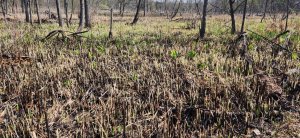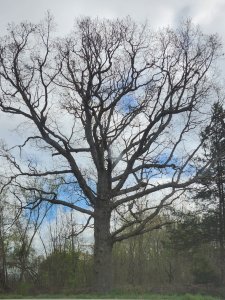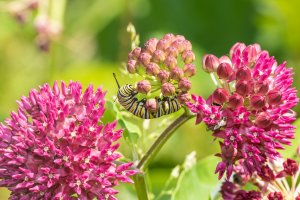A Savanna… in Michigan? Endangered, Rare Ecosystems and Human Impact
June 7, 2023
By Ali Groulx, Park Interpreter
“The strongest oak of the forest is not the one that is protected from the storm and hidden from the sun. It’s the one that stands in the open where it is compelled to struggle for its existence against the winds and rains and the scorching sun.” – Napoleon Hill
Oak trees are magic. Squirrels plant them, birds live in them, and in their stout, furrowed bark, spiders can find nooks and crannies to hide. If it’s near a lake, pond, swamp, or river, amphibians like salamanders and frogs can find refuge within the exposed root systems, and if they’re not careful, they could become a snake’s next meal. Oak trees are something of grandeur; they are familiar, evoking a sense of peace and stillness. They can provide us shade from the scorching sun as their leaves rustle gently with each wind gust. It’s no wonder that the first colonial, European settlers of this land chose to build their permanent homes right next to the oaks they found in wide, open prairies. These oak-inhabited prairies, called an oak savanna, are important places for animals and humans alike. Many rare species of plants and animals can be found within these oak savannas, many of which are threatened more and more as time marches on. Restoration efforts are tough; many of these ecosystems have now been paved over for human-dwellings and shopping centers. Information about their existence is derived from historical literature and data gathered from extremely disturbed sites, and we may never know them as the Anishanaabe did before European settlement. Oak savannas are important to our world, no matter how small their occupancy is now.

The oak savanna is a unique place, and one that is now difficult to come by. The Anishanaabe were the first people to utilize and often create these habitats. Maintained by intentional low intensity fire-setting, now called prescribed burns, these areas were an excellent place to hunt and spend time as a family. Oak trees are naturally fire-resistant with their thick, cork-like bark, and their fallen leaves in tangent with the prairie grasses helped encourage an even burn across the land. Oak trees grow their best when they have ample sunlight and less shrubbery around them, which is a main feature of the savanna habitat assisted by fire. Forests, by comparison, did not offer the same hunting and food production that a savanna could provide. Bison, deer, elk, and turkeys feasted on the abundance of acorns in these open transition areas between prairies and forests, unwittingly exposing themselves to the hungry humans camouflaged in the grasses. Mound-building ants called these places home, too, helping to develop the soil as they built tunnels and brought new soil up from the depths. Herbivores like deer helped keep the woody shrubs at bay by eating them before they could thrive. With the absence of necessity and understanding, habitats like these were in danger. European colonial settlers, upon arriving in Michigan, saw these magnificent open areas as similar to ‘parks,’ finding comfort in their familiarity and usefulness. It was a lot easier for them to occupy open land rather than clear cut an area, so these special habitats were some of the first to be destroyed in the throes of colonization.

Oak savannas are habitats where trees are a component, but they are not the main feature. The diversity of grasses and other herbaceous vegetation make this plant community stand out from others. Open-grown oak trees are a sight to see, although you would be hard pressed to find ones like the glorious elders that the Anishinaabe knew and respected. Nowadays, some great examples are the oak trees that have been planted by cities on the sides of and in between streets. You can tell an oak has been open grown by its impressive rounded canopy, stretching its branches as far as room will allow them. Open-grown oaks have thick lower limbs compared to oaks that spend their lives competing for sunlight in a forest. You will not find many trees with substantial lower limbs in a forested area, because those trees need to grow as tall as they can to spread out their crown to catch as much sunlight as possible.
There are remnants of old oak savannas that exist today, but a lot of them are degraded in quality. These degraded areas, although they may contain some open-grown oaks, might be laden with woody shrubs and weedy trees who only crowd the oaks and grasses, preventing the savanna habitat from persevering. In some instances, the only indicator that an area was formerly an oak savanna is a stately old oak tree with lower branch scars. These branches may have broken with age or became unable to take in as much sunlight as they needed to survive. When restoring oak savannas, a process called ‘daylighting the oaks’ may take place, freeing up the oak trees from any competition so they may thrive once more. Prescribed burns help keep the shrubby population down, maintain the soil composition, reduce invasives, and fire can germinate seeds so they can grow once more. Oaks are fire-resistant and tolerant of these instances of fire.

With climate change, issues like heavy flooding are affecting habitats that have a hard time healing. Invasive species make healing substantially harder. As shrubs and trees are damaged or killed by new, extreme weather events, invasives have an opportunity to take root and thrive. These plants can affect the soil, making it uninhabitable for native plants while taking up valuable real estate. The good news is that restoration efforts are already underway for these damaged habitats, providing shelter and food for many animals. Trees like swamp white oak, hackberry, winterberry holly, and willow are utilized to stabilize banks of flooded streams and rivers. Smaller trees planted by roadways, like yellowwood and red/white cedar, are able to absorb heavy air pollution from the cars driving by. Even though oak savannas don’t exist in the same state as they did before, they still support a plethora of life. Just because something is disappearing does not mean that it is no longer valuable. The early European settlers did not understand their impact on the land or the people who inhabited it. Today, we have the responsibility of defining what is important to us as Southeast Michiganders and sharing that knowledge and passion with others, especially the younger generations. Through understanding and knowledge, even if these habitats disappear completely, they will live on through the memories and stories of the people who once used oak savannas to sustain their lives. If you’re seeking out oak savanna habitat in southeast Michigan, visit Oakwoods or Lower Huron Metroparks.
